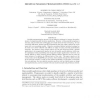Free Online Productivity Tools
i2Speak
i2Symbol
i2OCR
iTex2Img
iWeb2Print
iWeb2Shot
i2Type
iPdf2Split
iPdf2Merge
i2Bopomofo
i2Arabic
i2Style
i2Image
i2PDF
iLatex2Rtf
Sci2ools
PPL
2008
2008
Skeletal Parallel Programming with OCamlP3l 2.0
Parallel programming has proven to be an effective technique to improve the performance of computationally intensive applications. However, writing parallel programs is not easy, and activities such as debugging are usually hard and time consuming. To cope with these difficulties, skeletal parallel programming has been widely explored in recent years with very promising results. However, prototypal skeletal systems developed so far tend to be rather inflexible and difficult to adapt to many practical parallelization scenarios. For instance, many systems restrict all the sub structures inside a parallel application to be encapsulated together in term of possibly nested skeletons, which may be cumbersome when parallelizing some large and complex applications. Moreover, it is usually difficult to share resources among different skeleton instances and to reuse the same instance of a skeleton in different parts of the code. This paper reports on the current status of the OcamlP3l (2.0) sys...
| Added | 14 Dec 2010 |
| Updated | 14 Dec 2010 |
| Type | Journal |
| Year | 2008 |
| Where | PPL |
| Authors | Roberto Di Cosmo, Zheng Li, Susanna Pelagatti, Pierre Weis |
Comments (0)

